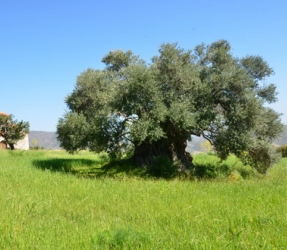Apart from the large chapel of the Holy Cross, Lefkara is full of chapels. This is largely due to the religiousness of the residents who contributed to the construction of about 18 chapels in various neighborhoods of the village and in the wider region. Apart from the large chapel of the Holy Cross, Lefkara is full of chapels. This is largely due to the religiousness of the residents who contributed to the construction of about 18 chapels in various neighborhoods of the village and in the wider region.
At the lowest point of the village, in the southeast, there is the famous "Píi" namely Pigi, which owes its name to a spring with running water all year long. From Pigi starts a downhill paved road that leads to the twin village of Kato Lefkara.
The visitor needs to walk only 1 km to get there, enjoying at the same time the natural scenery that, particularly in spring, is extremely green with all sorts of flowers. Blooming almond trees in February and blooming apricot trees in April give a unique note to the landscape.
At the entrance of the village is the chapel of Agios Timotheos and down the same road, the chapel of Archangel Michael with frescoes decorating its inside, both exquisite examples of Byzantine architecture.
The Image of Edessa – Fresco at the temple of Archangel Michael
The chapel of the Archangel is the only remnant of the "venerable Monastery of Asomatos of Lefkara". Byzantinologist Athanasios Papageorgiou dated this monastery to the 12th century, when many other monasteries were founded as well, as he mentions.From Lefkara, going downhill to the north, to the road leading to Kornos and taking the path at the end of the village, within 20 mintes you will reach the Byzantine chapel of Panagia Livadiotissa, an exquisite sample of Byzantine architecture.
From here you can enjoy a panoramic view of the valley of the river Sirkati with the impressive rock of Kourvellos at the center.
Several centenarian olive trees, the so-called "fragkoelies" because they were planted during the Frankish occupation, throw their shadow on the meadow next to the chapel.
The ascent to Sotira and the view from its top
In the southwest of Lefkara, in an imposing and prominent position, stands the chapel of the Transformation of the Savior known by the name "Sotira", which also gave its name to the respective mountain. You can reach this chapel via an ascending path that starts at the monument of the fallen and about 20-minute hiking. Alternatively, you can go there by car in just a few minutes.
The Church of the Savior (Sotira) dates back to the 14th century and its founder is Father Gabriel, who is also considered to be the founder of the great Church of the Holy Cross.
From the top of Sotira, the visitor can enjoy the amazing view that lies in front of him as far as the eye can see. The landscape around Lefkara is magnificent.
At the foot of the mountain of Sotira lies the valley of Lefkara, amphitheatrically, with the tiled roofs of the village pleasantly coloring the landscape.
At the north, you can gaze at the hillside of the "castle", with the rugged peaks of the surrounding hills and at the far eastern horizon lies the sea of Kition, reflecting the sunlight.









